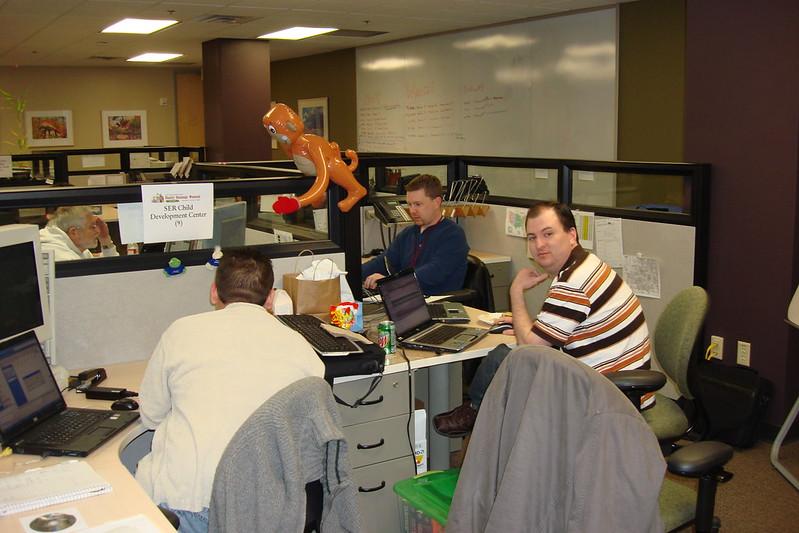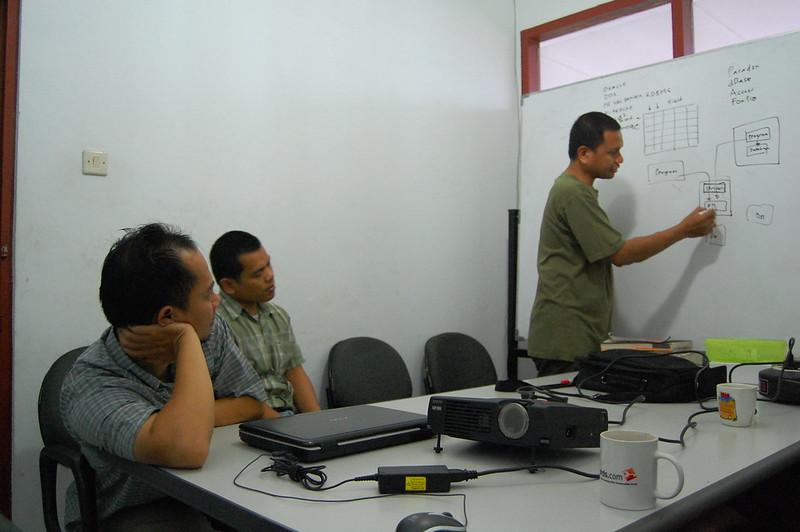Backend developer is one of the professions that attract the most young people because of its high salary and many advancement opportunities. So how to become a backend developer?
Everyone’s career path is not the same. To me, there are seven steps you need to go through to get this job. I will walk you through each step in detail.
Keep scrolling to discover!
Overview of Backend Devs
You need to have a good understanding of the backend developer job before applying for it. I will describe the roles, duties, and work environment.
Who Is A Backend Developer?
Backend developers are the tech experts who build and manage the hidden parts (backend) of websites, apps, and online services.
Instead of working on what you see (the design), they deal with how things work. They use programming languages like Python, Java, and others to create databases.
These developers also make sure that different parts of a website or app can talk to each other. They work closely with front-end developers, and together, they create fully functional digital stuff that can handle lots of users and data.

Job Duties
As a backend developer, my role involves several crucial job duties:
- Create and maintain the core logic of apps and websites.
- Create databases to store data.
- Build APIs that let different parts of apps talk to each other.
- Add locks and security measures to keep the data safe from bad guys.
- Optimize the backend to handle a large number of users and ensure smooth performance.
- Team up with others.
- Identify and fix any issues that arise
- Create guides to help others understand how things work behind the scenes.
In short, my job is to build the foundation that supports the entire digital product, ensuring its reliability, efficiency, and security.
Working Environments

When you become a backend developer, you mostly use computers to write code and make systems. You can work in offices, new tech companies, or even from home.
When working on projects, you’ll team up with other experts like front-end developers, designers, and managers to create cool apps or websites.
Sometimes, work can be super busy with tight deadlines. Other times, it can be more relaxed and creative. It’s up to you whether you have multiple projects to complete.
How To Become A Backend Developer
While this job can not require a Bachelor’s degree, it does require in-depth knowledge, including scripting languages, databases, frameworks, and more.
I will guide you step by step to acquire this knowledge and put it into practice.
1. Get A Bachelor’s Degree (Optional)
Thinking about getting a Bachelor’s degree to become a backend developer? It could be helpful, but not a must.
A Bachelor’s degree teaches you essential knowledge about computers and coding. You can learn how to make programs and handle data. Plus, you’ll get good at solving problems and know how the software works.
If you’re aiming for this degree, the following majors are a good fit:
- Computer Science
- Information Technology
- Software Engineering
- Computer Engineering
- Data Science
But you don’t have to go to college for this knowledge. Some of my co-workers learned by themselves online or in coding classes. So if you’re good at learning by yourself and can show your skills, you don’t need a degree.
Thus, if you want a deeper understanding and more schooling, go for the degree. But if you want to start coding sooner, there are other paths.
2. Learn Programming Languages

Learning programming languages is a key step in getting this job because if you want to build apps, games, or websites, you need these languages to make them functional and interactive.
You can start by selecting a language commonly used in this field. Popular choices include Python, JavaScript, Ruby, and Java. Each has its strengths, so consider factors like your goals and the tech community around each language.
After choosing a language, you need to learn its fundamentals, including variables, data types, loops, conditional statements, and functions.
Besides, I recommend learning about the OOP because most backend languages use OOP principles. You need to know concepts like classes, objects, inheritance, and encapsulation. These ideas help you organize and manage your code.
3. Learn About Databases

The next step is to learn about databases. So why do you need this knowledge? Here are the reasons:
- Storing and finding data: Databases are where apps keep user profiles and product details safely. They’re like digital drawers for data, making it easy to find things when needed.
- Managing lots of data: Databases help keep tons of data all neat. So nothing gets jumbled up or lost.
- Speeding things up: Learning to make databases work fast is important because apps shouldn’t wait forever to get data from a database.
To get familiar with databases, you can start by learning their strengths and when to use them. You’ll encounter different database types, such as relational databases (like MySQL and PostgreSQL) and NoSQL databases (like MongoDB).
Many websites offer free or paid courses on this knowledge. I recommend Codecademy, Coursera, and Udemy because they have beginner-friendly lessons.
To practice, you can set up a small database on your computer or use online tools. You can create tables, insert data, and practice running queries. Learning by doing is powerful.
4. Learn Framework(s)

Another thing you need to learn in this process is frameworks. Frameworks are like pre-built toolkits that help you create web applications more efficiently. Here’re some popular frameworks:
- Django (Python)
- Ruby on Rails (Ruby)
- Express.js (JavaScript)
- Spring Boot (Java)
- Laravel (PHP)
- ASP.NET Core (C#)
With frameworks, you can make your app look cool without being a design expert because they often have styles and layouts you can use. And as your app gets bigger, frameworks can handle the growth without things getting messy.
To learn a framework, you can follow my tips:
- Start with the framework’s official documentation. It explains how everything works.
- Follow online tutorials to build simple projects using the framework.
- Work on more complex projects to explore advanced features.
- Explore open-source projects built with the same framework. Reading code written by experienced developers helps you learn new techniques.
Incorporating frameworks into your work toolkit can help you create robust, feature-rich apps.
5. Work On Personal Projects

Working on personal projects can enhance your skills before becoming a proficient backend developer. This step determines whether you are qualified to apply for this position. Here’s my advice to effectively work on your projects:
- Choose projects you like: It could be something related to your hobbies, a problem you want to solve, or a tool you’d find helpful.
- Start small: Building a complex app from scratch might lead to frustration. Start with a single feature or a simplified version of your idea.
- Plan and design: Before coding, plan your project’s structure, features, and user experience. Sketch out a basic design and outline the features.
- Use what you’ve learned: Implement the backend concepts and programming languages you’ve learned.
- Version control: Use Git to track your changes. This tool can keep a history of your project’s progress.
- Incremental development: Break your project into smaller tasks or milestones. Tackle one task at a time and build upon your progress to prevent feeling overwhelmed.
- Document your work: Write comments in your code and keep a development log to understand your thought process. Also, you make it easier for others to follow your project.
In this process, I know it’s easy to lose interest. So my advice is to aim to complete your projects, as having finished projects in your portfolio showcases your dedication and ability to see things through.
Remember, personal projects are about the result and the learning journey. They allow you to experiment, fail, learn, and grow as a backend developer. So, pick an exciting idea, roll up your sleeves, and start coding!
6. Learn About Hosting

Hosting means putting your projects on the Internet so others can see and use them. When you show hosted projects in your portfolio, it shows employers you can take an idea and make it real.
Choose hosting providers that suit your project. Popular choices include Heroku, AWS, DigitalOcean, CDN, and Netlify. These services usually have guides that explain how to put your projects online.
When learning about hosting, you need to understand related things like servers (computers that store websites) and domains (web addresses).
Because different projects require different deployment methods, you need to know which is for your project. For example, if you’re building a static website, deploying it through a CDN ensures faster loading times.
My advice is to practice with simple projects first. Practice regularly to master this skill. If you’re stuck, ask others for advice.
7. Apply For Jobs

Now you can apply for this position as you have a strong educational foundation and some projects.
When searching for jobs, the first thing you need to do is to learn about the company’s products, culture, and values. This way, you’ll know the vibe of the workplace.
Then, if you don’t have a resume, build it. If you’ve had one, tailor it to highlight relevant skills, experiences, and projects.
If a company is satisfied with your resume and asks for an interview, prepare well for that interview because it will determine whether you get the job. Be ready to discuss your projects, coding approach, and problem-solving skills.
Remember, each application and interview is a chance to learn and improve. Be genuine, demonstrate your passion for backend development, and keep refining your skills along the way.
Why Should You Become A Backend Developer?
Becoming a backend developer is an excellent choice for the high incomes, good job outlook, and diverse job opportunities,
Firstly, you can make a decent amount of money. In 2023, a backend developer earns around $128,680 per year with base pay and extras.
Secondly, the future looks bright because there’s a high demand for software developers. The number of jobs in this field is expected to increase by 25% from 2021-2031 (about 150,000 new jobs/year).
Finally, every industry relies on software applications. So backend developers can work in various sectors, from finance to healthcare, entertainment, etc.
So, if you want to become a backend developer, you’re heading into a job that pays well and has plenty of opportunities.
Skills Required
In terms of skills, this job requires both hard and soft skills. Here are some skills you need to build now:
- Coding
- Using frameworks for backend tasks
- Creating, managing, and designing APIs to make parts of your code talk to others.
- Storing and getting back data from databases.
- Using web servers to show your website to others.
- Being skilled with Git to manage changes in your code.
- Testing and fixing.
- Protecting your code and data from dangerous elements.

- Problem-solving.
- Being meticulous in code writing, testing, and debugging to ensure high-quality apps.
- Effectively communicate with team members, clients, and stakeholders to discuss requirements and project updates.
- Be organized to finish tasks on time.
- Be creative in designing elegant solutions and optimizing performance.
In short, this job requires a combination of technical expertise and soft skills to build functional, secure, and efficient web applications while collaborating effectively with others.
How Long Does It Take To Become a Backend Dev?
The time it takes to become a proficient backend developer varies, but typically, you need at least 4 years if you’re a beginner.
If you’re starting with no coding experience, it might take 6 to 12 months to grasp the basics of programming, databases, and backend concepts.
With consistent effort, you could become comfortable with core backend technologies in about 1 to 2 years. During this time, you might work on small projects to practice and apply what you’ve learned.
For those with some coding experience, your journey might be faster. You may progress to learning backend specifics within 6 to 12 months and reach proficiency in about a year or less.
However, the timeline isn’t fixed. It depends on the time you can dedicate daily, the quality of your learning resources, and your ability to grasp the concepts.
Conclusion
So we went through the steps together in this guide on how to become a backend dev. This job requires you to have the ability to self-study to gain in-depth background knowledge. You can then apply that knowledge in your projects to impress employers.
